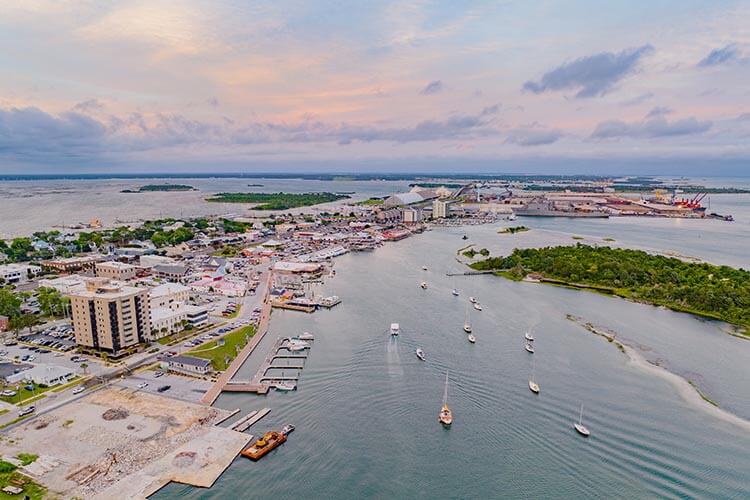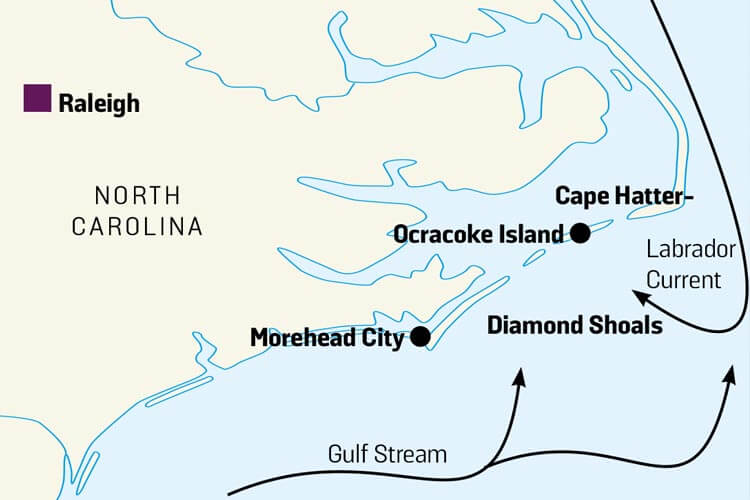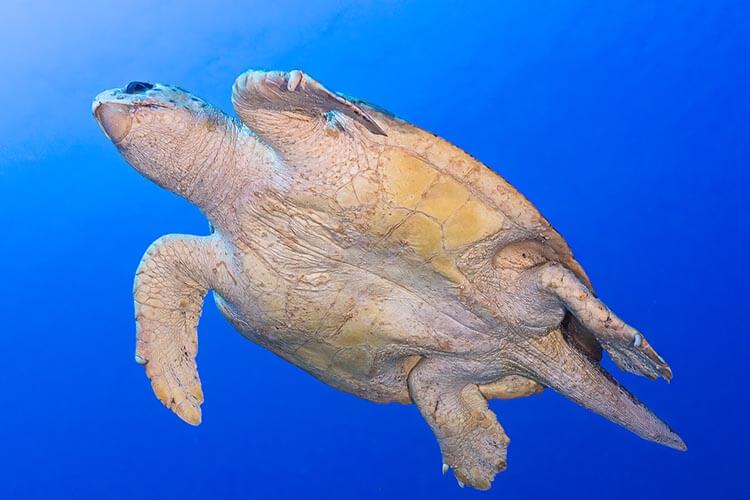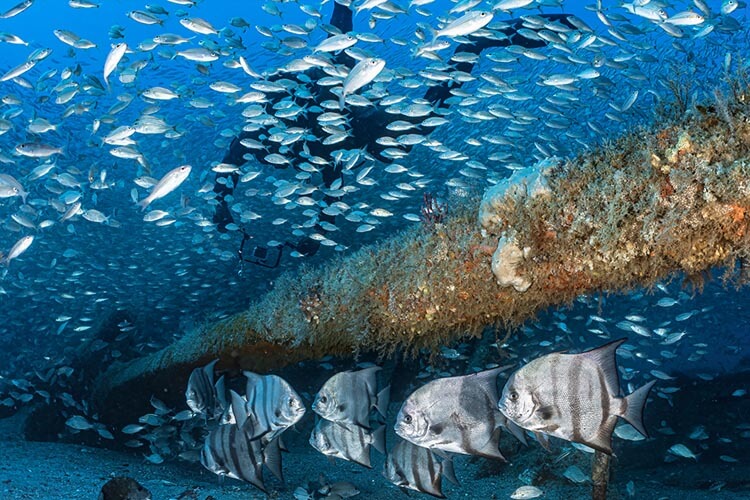
The treacherous coast of North Carolina is littered with wrecks. Timo Dersch checks out some of the most impressive and meets the regulars who often gather in large gangs
The notorious British pirate Edward Teach, better known as Blackbeard, died on Ocracoke Island, the hideout from where he terrorised the rich colonial trade along the coast of what is now North Carolina.
In the early 18th century, ships laden with goods from the Caribbean and the American colonies had to sail through the treacherous shoals and shifting sandbanks of the area – easy pickings for a pirate who knew the waters well.
The Diamond Shoals remain a difficult stretch of water to navigate. ‘There are two major currents meeting here at Cape Hatteras – the Gulf Stream and the Labrador Current’, author and shipwreck expert, ‘Keeper’ James Charlet explains.
‘Their meeting can be described more as an explosion, moving a great deal of undersea sandbars in unpredictable ways.’


Thousands of vessels have fallen foul of the erratic seas in which charts are out of date before they are printed. Even today, ships get stuck and sink into the sands. This is not only a gift for ruthless pirates, but has created a staggering number of wrecks for divers to explore.
There are more than 5,000 known wrecks in the area – historic sailing ships from the 17th and 18th centuries, warships and submarines from the First and Second World Wars and modern-day merchant vessels.
‘German submarines would sneak up and sink as much as they could’, said Marc Corbett, ship historian and boat assistant aboard the Lion’s Paw charter dive boat, which explores the diving grounds around Hatteras Island. ‘But since the subs were not invulnerable themselves, four German submarines can be found, two of them have become highlights of underwater exploration.’


And there is much more to discover in the sand graves. Marc is looking towards the horizon while navigating the boat through the difficult inlet passage. ‘We have been
looking for some of the ships for years. We know they should be there, but the harsh weather conditions out here limit us so much in our search.’
The weather plays a vital role in diving in the area. If the conditions are right, you can head out into open ocean more than 20 nautical miles offshore, where the bigger wrecks lie.
We headed out on such a trip with Olympus Diving, based in Morehead City, to check out the Aeolus – a former cable-repair and cargo transport ship which sank in 1988.
FIVE WRECKS NOT TO MISS
Aeolus
Sunk as part of an artificial reef system in 1988, the former cable repair ship is 120m long (400ft), sits in 33m (110ft) of water, and has been broken into three major pieces by the tropical storms that often hit the North Carolina coast. The wreck is renowned for the abundance of sand tiger sharks, many often found lurking inside the structure.
Proteus
This 118m-long (390ft) luxury passenger liner sank in a collision in 1918 and sits in 40m (120ft) of water. Although she is old and is comprised of a large debris field, she still has the appearance of a ship. The water surrounding this site is often warm and is clear due to Gulf Stream currents. The Proteus is also a hot spot for encountering sand tiger sharks and various other types of marine life, such as large rays and groupers.
W E Hutton (formely known as the Papoose)
Historians now think this 138m (435ft) tanker torpedoed by a German submarine in 1942 is actually the W E Hutton. The Papoose was another large tanker sunk by the same sub on the same day. However, many dive operators still refer to it as the Papoose. It sank on its port side, but shifted over the years and now lies almost completely upside down. You can penetrate the wreck in several places, and sand tiger sharks often hang out inside. Thirty-six nautical miles offshore in the clear waters of the Gulf Stream, means visibility often exceeds 30m (100ft). The depth along the wreck ranges from 27 to 37m (90 to 120ft).
USS Schurz
The USS Schurz started life as a German gunship, built in 1894. Shortly after the outbreak of the First World War, the ship was seized by the US government and later drafted into service in the US Navy. In the final months of the war, she collided with a merchant ship travelling without lights, and sank. The wreck lies in 28–34m (95–110ft). The boilers, engine, port anchor and deck guns on the bow and stern are still intact. Dense schools of baitfish and sand tiger sharks regularly gather.
U-352
This German U-boat targeted Allied ships travelling along the North Carolina coast during the Second World War. It was hit by depth charges in May 1942 and lay undiscovered for 30 years, until located by the owner of Olympus Dive Center in 1974. It lies on its keel at 30m (100ft) with a 44-degree list to starboard – the conning tower is intact.
It’s a long journey but the dive boat was big – more like a liveaboard, with plenty of room to relax. Descending along the anchor line, we could feel we were out in the open ocean.
There was a fair amount of current, nothing too crazy, but enough to make sure you never forgot that the ocean is in charge. Great barracudas were standing in the current next to the line. Schools of jacks were dancing around a little closer to the upper side of the wreck.
The ship is broken into several pieces. Due to its massive size, we focused on the bow section. Schools of tomtate grunts gathered around the giant ship. Descending deeper, we found beautiful pink gorgonian fans, attached to the metal structure.
But one thing was missing – perhaps the star attraction and why so many divers are happy to spend hours on dive boats to explore these wrecks. None of the sand tiger sharks that are known to gather around these wrecks in – at times – surprising numbers were present.



One of the other divers started spearing the invasive lionfish which now plague the Caribbean and American coastline. Slowly and graciously, a sand tiger glided from the twilight over the grey sand towards the boat to see if there might be an easy meal involved for him, too. It was the only shark we saw that day, but on other days it can be drastically different.
‘Sand tigers may congregate on the wreck sites in extremely large numbers during the summer season,’ a skipper on another trip told us. ‘You may not see any at a wreck site, then you may find hundreds of them there the next time you dive the same site. They are often more plentiful at the deeper wreck sites, but may be in large numbers on an inshore shallow site as well.’



There is one particular site, he said, where the sand tigers gather in profusion. ‘At the Proteus wreck, I have experienced dives when I could see at least a hundred of these sharks in any direction.’ He continued: ‘On several occasions at the end of the dive, I have pulled the anchor and drifted underwater with the current for over a quarter of a mile and found there were just as many sharks away from the wreck as were seen at the wreck site.’
Not only sand tiger sharks can be found here. Great whites, makos, tiger sharks and hammerheads have all been known to rock up. The wrecks are also home to an abundant variety of marine life. Rays the size of small cars, loggerhead sea turtles nestled into a quiet corner of a wreck, octopus, moray eels and millions of small schooling fish.
The keen-eyed can also spot numerous small treasures hiding in the cracks and holes. Macro life is plentiful, including seaweed blennies, sea spiders, nudibranchs and plenty of frogfish.
The wrecks of North Carolina have something for everyone!
NEED TO KNOW:
Getting there: By international or domestic flight to Raleigh/Durham airport. From there, take a rental car to Morehead City or Hatteras Island.
Dive operators: Olympus Dive Center, Morehead City olympusdiving.com & Dive Hatteras, Hatteras Island divehatteras.com
Further information: visitnc.com, crystalcoastnc.org and outerbanks.org
More great reads from our magazine:



